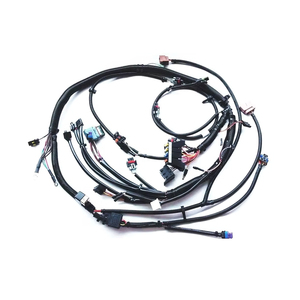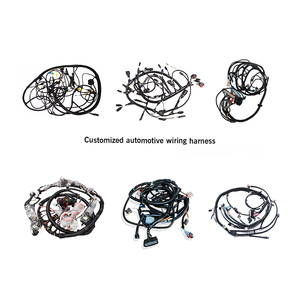
All categories
Featured selections
Trade Assurance
Buyer Central
Help Center
Get the app
Become a supplier

(1540 products available)




















For any car, a wiring harness is crucial as it links various electrical components, enabling the smooth operation of circuits. There are different types of wiring harnesses, each suitable for specific automotive setups. Therefore, the choice depends on the car model, engine type, and desired features.
The gm hei distributor wiring harness is designed explicitly for GM HEI (High Energy Ignition) distributors, whereas a universal wiring harness connects various electrical points in an automobile. Though such wiring harnesses can be used in multiple cars, specialized wiring harnesses are only applied to particular types of distributors or engines.
It is vital to discuss the materials that construct a wiring harness to provide insight into the durability of a gm hei distributor wiring harness. Common materials used to create automotive wiring harnesses are copper, PVC insulation, plastic connectors, and heat-shrink tubing.
Copper
Copper is the primary conductor used in the gm hei wiring harness due to copper's exceptional conductivity, flexibility, and resistance to corrosion. Compared to other metals, copper wiring better helps transmit electrical currents with less energy loss, making it ideal for complex vehicle electrical systems.
PVC insulation
PVC, or polyvinyl chloride, is the most common insulation material for automotive wiring. Its durability, flexibility, and ability to withstand temperature extremes make it ideal for the harsh environments that vehicle wiring often encounters. Insulation serves to protect the wires from short circuits, moisture, and physical damage due to heat or cold.
Plastic connectors
Plastic is the most common material for automotive connectors due to its lightweight nature and resistance to corrosion. Such connector types include terminal connections and boss connectors for HEI distributors. This versatility makes it possible to create durable, easy-to-install connectors that serve this purpose well. Nevertheless, the plastic degrades with time, especially when exposed to constant UV light and heat. These elements are frequently found in automobiles.
Heat-shrink tubing
Heat-shrink tubing provides an extra layer of protection for exposed sections of wiring, ensuring durability. This plastic tubing is generally used at the joints and connectors to protect the wiring from moisture, abrasion, and excessive heat. Moreover, heat-shrink tubing effectively seals and prevents the exposed wires from coming in contact with one another, which may lead to short-circuiting.
The distributor wiring harness is extensively used in the automobile business. It connects the vehicle's ignition system to the engine, sending the right electrical signals. In commercial auto settings, wiring harnesses maintain engine efficiency and decrease the need for repair by withstanding the daily environment.
Long-lasting materials
Tough materials that withstand the heat and vibration an automobile experiences daily are critical for a gm hei wiring harness in commercial settings. It's vital to have a structure made from such materials to maintain the system's effective functioning and avoid downtime caused by frequent repairs or displacing of parts.
Efficient installation
The distributor wiring harness is easy to install in commercial automobiles due to its design. In a commercial automobile, time is of the essence. Therefore, the harness must be simple to connect with an HEI distributor to do the installation without having to perform too many complex maneuvers.
Ensures reliable performance
In commercial automobile business applications, operational effectiveness is always pursued. A HEI distributor wiring harness effectively liaisons electrical components, ensuring the distributor works correctly. This means vehicles will have improved ignition timing, increased power, improved fuel efficiency, and more dependable performance overall.
Versatile Compatibility
In commercial applications, general-fit harnesses frequently have broad compatibility with many GM cars. This adaptability is beneficial in fleet operations, where many vehicles are of the same model. In such cases, having a harness that fits numerous cars guarantees component uniformity and simplifies repair parts inventory management.
The GM HEI distributor wiring harness is perfect for several automobile applications. To establish which harness is best for optimal functioning, knowing about the various situations is crucial.
Engine Swaps
Holders swapping their engines for a GM engine will need the GM HEI distributor wiring harness. The wiring harness transmits the required electrical signals between the HEI distribution and the new engine. Such an arrangement guarantees that the engine swap works without any defects.
Performance Upgrades
Installing a High Energy Ignition (HEI) system on a stock car to boost engine output is known as a performance upgrade. This increase generally results in increased fuel efficiency and more combustion power. Hence, a GM HEI wiring harness will be required to ensure that the ignition system works seamlessly with the engine so that performance enhancements do not conflict with the vehicle's electrical system.
Restoration Projects
Classic cars normally need a GM HEI distributor wiring harness. Most classic cars rarely run effectively because their ignition systems are worn or have a faulty connection. Thus, for restoration enthusiasts who intend to breathe new life into a classic vehicle, installing an HEI ignition system and an applicable wiring harness will deliver a contemporary, dependable performance to the restored classic car.
Custom Builds
Custom motor enthusiasts install the GM HEI ignition system and the wiring harness in their bespoke builds to create a more manageable and efficient ignition setup. This is especially crucial for bespoke cars with unique electrical settings because the wiring harness ensures perfect connection and system compatibility.
Choosing the right wiring harness for a car depends on various factors one needs to consider. Key considerations are listed below for selecting a GM HEI wiring harness that would suit a vehicle.
Vehicle model and year
The vehicle's make, model, and year are critical elements in this process because of the variations in electrical systems over time and between models. Only the GM HEI distributor wiring harness compatible with the original car wiring will work properly. Such compatibility helps avoid installation problems and system malfunctions.
Type of ignition system
Directly linked to the type of ignition put in the automobile, the wiring harness selection depends significantly. If a customer uses a stock GM HEI ignition system, go for a factory-style harness that matches the vehicle without modifications. For after-market HEI systems, a universal or custom-fit harness is needed to ensure such a system has electrical compatibility.
Wire gauge and material
Wire gauge determines the amount of electric current that can pass through a wiring harness without overheating. Ideally, heavier currents need larger gauge wires. Conversely, high performance HEI ignition systems require thicker-gauge wiring, while stock systems can function with standard-gauge wire. Also, ensure that the wiring harness is made from copper wire for maximum conductivity.
Connector fit
For the proper functioning of a wiring harness, the connectors that attach to the GM HEI distributor must match the vehicle's engine. Misfitting connectors will lead to operational disruption or unsafe harnesses. In this case, whether there are no disconnects or they can be offered by an adapter, ensure the kind of connectors involved are compatible with the automobile.
Check for added features
Additional features such as heat shielding, protecting a wiring harness from harsh external elements, are worth considering. And so does the dielectric grease in the connector to enhance moisture sealing and prevent corrosion. Such features ensure car harness sustains longer and gives effective service.
A: A GM HEI distributor wiring harness is purposely designed to connect the GM HEI ignition system to the engine management system. It transmits electrical signals between the ignition system and engine to make the proper steps for combustion.
A: Installing the wiring harness involves first connecting the harness connectors to their respective terminals. Then, secure and insulate the wiring properly and at the right angle. Finally, check the wiring carefully to ensure the systems are functioning properly.
A: Regularly inspecting the wiring harness of a vehicle for signs of wear, fraying, or corrosion is one way to prevent its early demise. Moreover, harness protection might be improved by heat-shrink tubing or cable ties in appropriate places.
A: Wiring harnesses are often made out of copper wiring insulated by PVC. The insulation protects the wires from abrasive surfaces and environmental factors such as moisture and heat.
A: Wire gauge, material, and connector type are important factors to consider when purchasing an appropriate GM HEI wiring harness. Also, additional harness protection covering for insulation might be useful in harsh environments.